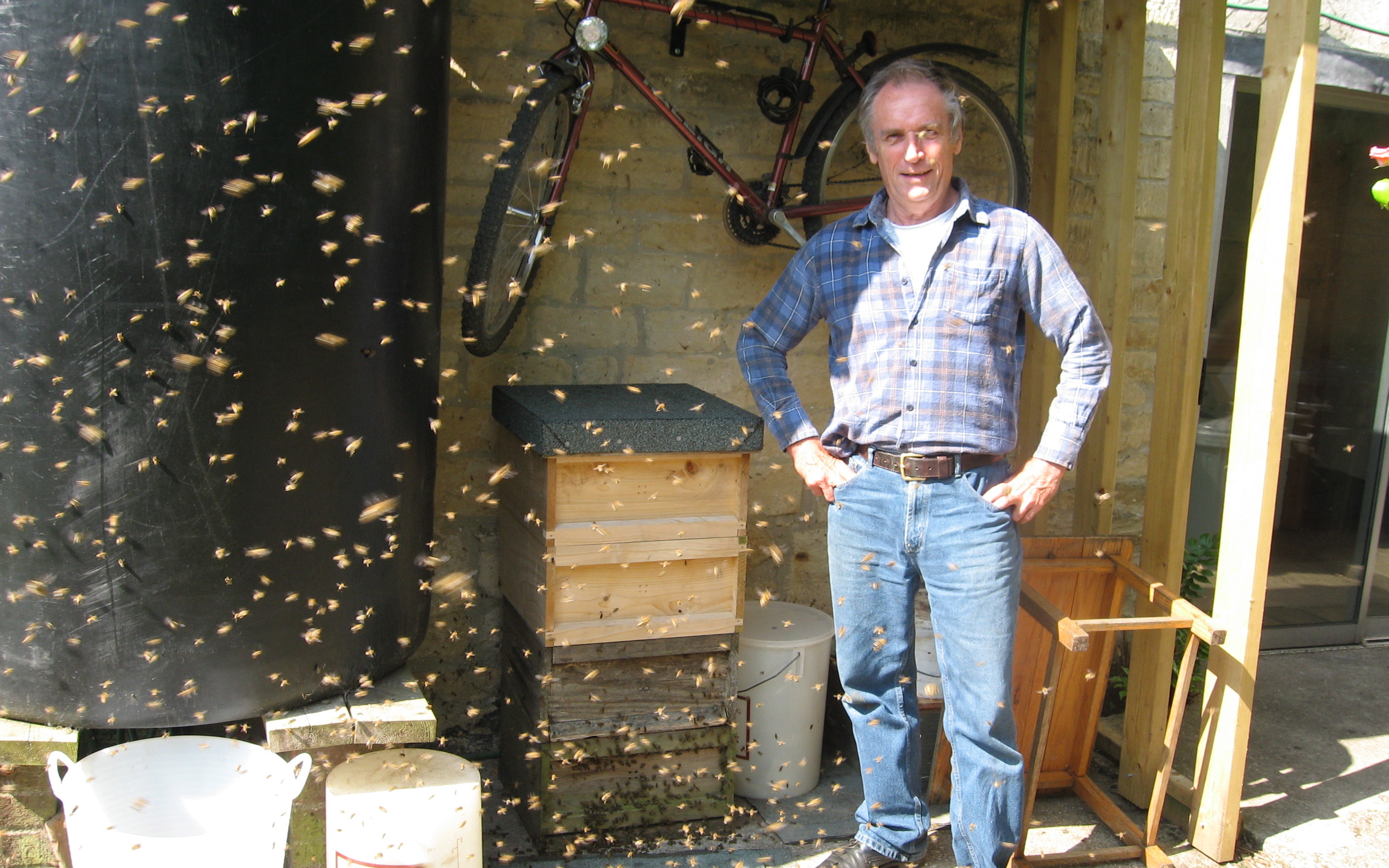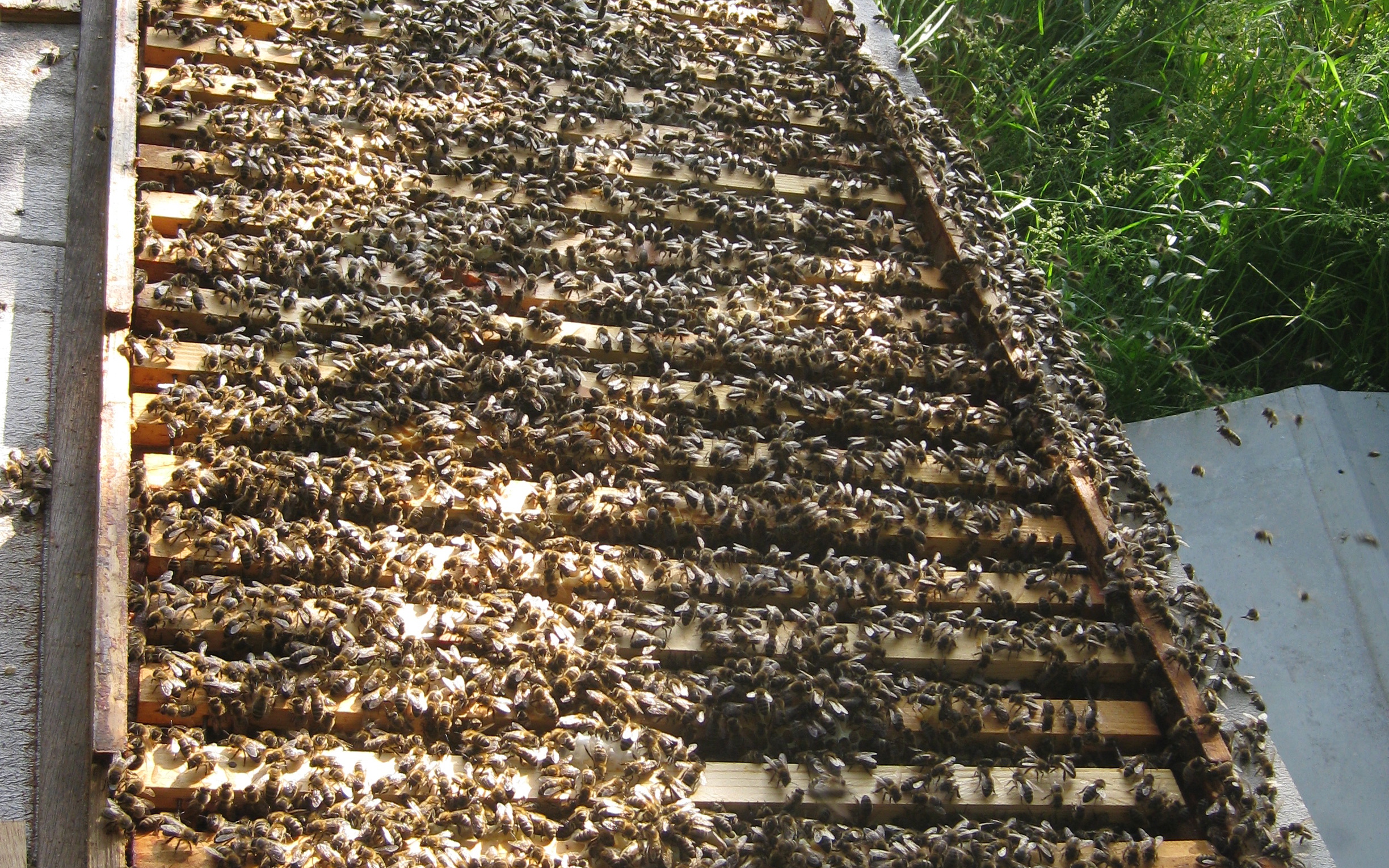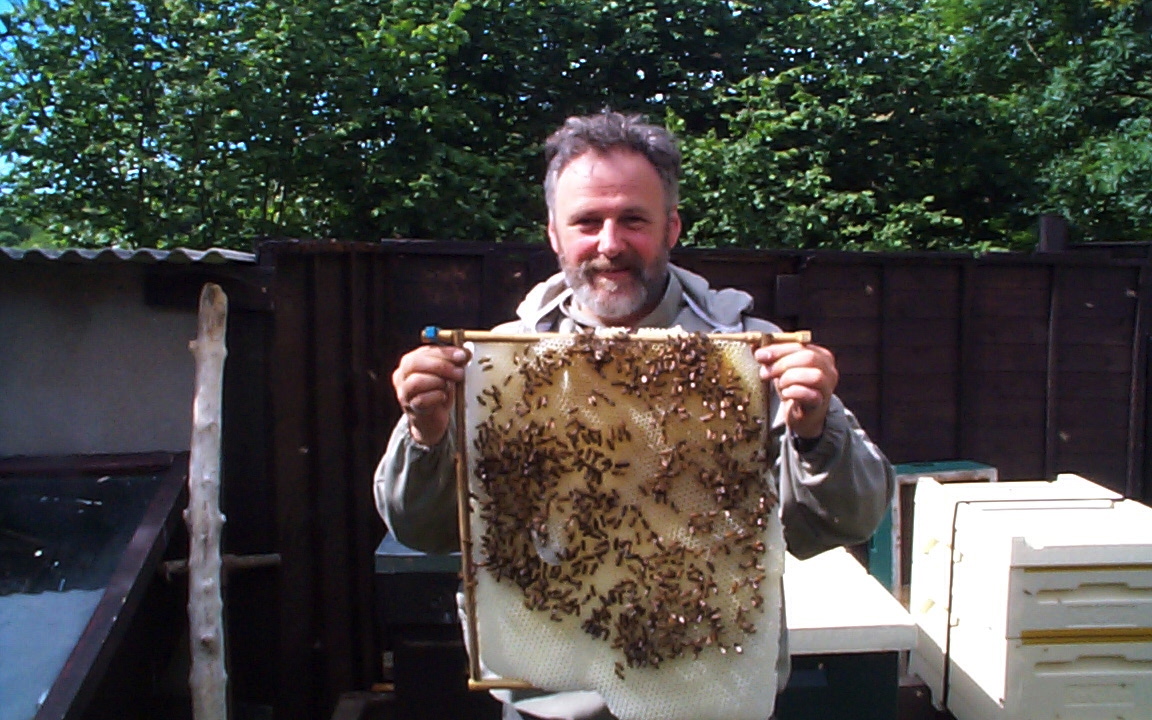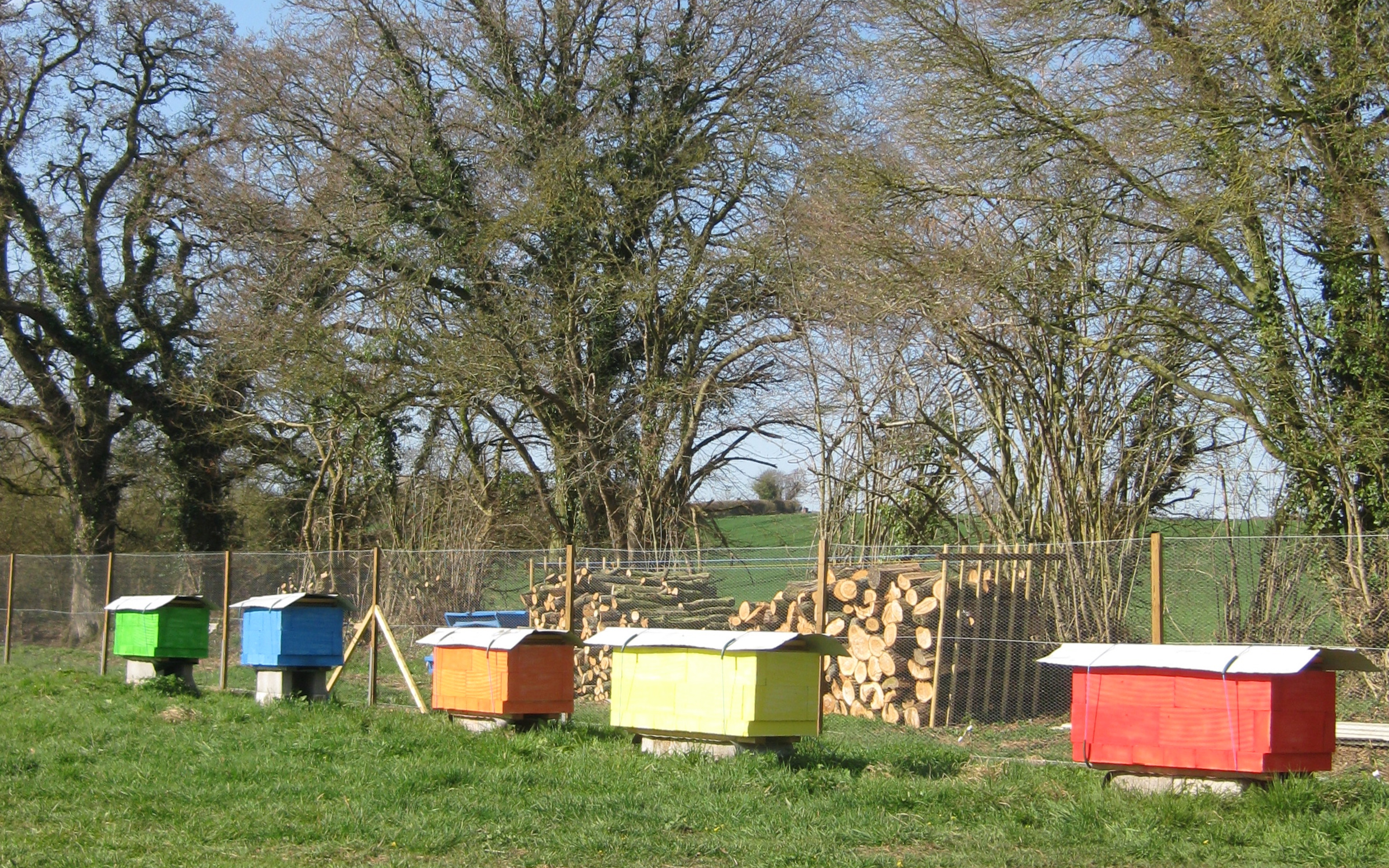
Design
You cannot better the world by talking to it.
Philosophy, to be effective, must be mechanically applied.
Buckminster Fuller
External Envelope See Drawing 7
Wood hives have the benefit of being amenable to a split inspection for queen cells unlike the ZEST. If a queen cell inspection is carried out on a 100% frame basis it requires the inspection of every frame with brood on it, but only overcrowded hives swarm. If they become overcrowded they can do so very quickly. An active management policy is called for which takes away brood, bees and honey to pre-empt a swarm and make controlled rather than uncontrolled increase.
It is contended that the benefits of a ZEST will be better tempered bees that are less likely to swarm. The ZEST is a more comfortable hive for the bees to fulfil their needs, and without an excluder which encourages swarming. This is important in swarm prevention. Honey can be constantly being removed from a ZEST that would block up the brood space. New empty frames are added to keep the bees busy.
The bee paramount ambition is to assist the bees in thermo regulating the brood nest in a warm dry envelope. Slugs may be common in traditional hives, but none have been reported in a ZEST. The ZEST hive design facilitates warm and dry by having a thermal mass, insulation all round with top entry and trickle ventilation which prevents the stack effect draft.
Why should they be bad tempered?
Why should they leave?
Conventional wood hives are visited by the beekeeper for the following reasons:
1. Spring clean, disease scan and to spread the brood.
2. Stimulation feed.
3. Weekly inspections to check for swarm cells, spread brood, to add boxes and move honey blocks into supers (if only brood boxes are used).
4. Assembling mostly capped honey to be taken by employing Porter bee escapes, enticing the bees down onto box of fresh comb of foundation.
5. Collecting honey two days later.
6. Returning wet frames to the hive for cleaning up after extraction.
7. Taking shook swarms, artificial swarms and nuclei.
8. Called to site to recover damage or swarms.
9. Feeding for winter and treating against Varroa and Nosema.
Some of these operations can be carried out at the same visit, but not on all of the hives at the same time. The logistics of actions on site visits can be compared to a complicated military campaign with a lot of travelling involved.
By comparison the logistics of the ZEST hive management system is as shown in Drawing 8. Apart from the compulsory visits expressed there the system can be “let alone”. The insulated partition boards will need to be moved regularly to ensure a compact brood nest without crowding it. This is also the opportunity to take honey on a frame by frame basis when it is sealed, cutting it into tubs for removal or to use the ZEST nucleus box with Canadian escapes to clear the bees for taking later.
Not only is the ZEST hive a third of the cost on a frame area match, the labour and time needed to gather it is also about a third.
Frames See Drawings 9, 10 and 11
It was determined that the three frame choices should be available depending upon the context.
1. The ZEST collapsible bamboo frame. Drawing 9.
2. The ZEST stapled wood frame. Drawing 10.
3. The ZEST plastic, gravity frame. Drawing 11.
The first 2 were tested in quantity during 2011. The last was tested during 2013 and proved the concept. Refinements on the patented prototype were initiated and investors are being sought to pay for the tooling costs.
The first choice was for the ZEST collapsible, bamboo, gravity frame which has the merit of being suitable for making, using and exporting from a third world country. It can also be collapsed, shipped around the world, shaken out and put into ZEST’s without further work. To make 200 of these frames by hand took about 12 hours. The pieces cost about 40p .for each one, made in this country, but in China would be made from a free, in the garden, weed. A 2400 long cane makes one frame. A hive tool is not needed to lift it from the colony. The bees do not stick it down as much as the machined frame. Felt tip marks need to be made on the top frame bearer to space the frames.
The second choice was for the ZEST stapled, wood, spacer, frames which can be used if machine technology is available. It costs about 40p for the material and machining it. It was very strong vertically, but not horizontally when levered apart. Gimp pins were driven through the top bar at each end into the side bars to fix the joint laterally.
The third choice is the injection moulded plastic frame. Plastic is a by/waste product of the fuel industry, but once obtained is recyclable. It is a useful legacy of the oil industry.
The plastic one remains a work in progress.
The Bamboo Frame. (Drawing 9)
Brush the horizontal bars with hot wax so that the bees can get a grip on it upside down and draw the comb from below more readily. 40mm. brass paper connectors that are usually used to hold together bank statements, now hold the bamboo together at the junctions. Do not be deceived. They are only brass plated and prone to rust if they get wet.
They have the
following virtuous, yet shockingly fashionable qualities
being:
Bees starting to fill a bamboo frame
Collapsed for storage and delivery
Frame opened out
The bamboo frames in situ
The Wood Machined Frame.
(Drawing10) Strong enough, but more wax starter strips are needed.
Frame with 2 parts brood and 1 part honey, which could have been taken.
The wood frames in situ.
The Plastic Frame. (Drawing11)
Pass the toast Prototype ZEST Plastic frame being drawn out and filled. No more foundation. No more wood. No more gimp pins. No more wonky frames with wonky joints. No more cleaning up old frames. No more broken frames to be repaired. No more disease on frames.
ZEST – DOING MORE WITH LESS
Construction
The ZEST Hive
What better building technology has become available for a new approach to hive construction that was not available 160 years ago?
Are technologies available that will resolve the many deficiencies of existing wood hive designs which have continued in use for many years without fundamental change and in which changes are merely variations on an already poor tune?
Consider the motor car and aircraft of 100 years ago and now.
Now consider beehive designs. They have not changed over 160 years, despite the existence of materials, knowledge and techniques which could have improved them. Funeral Directors appear to be revolutionary zealots when compared to beekeepers.
Can different modern materials and a new approach to hive design facilitate a more productive honey gathering regime, which is better for the bees? The following is suggested.
1. Corrugated sheet metal for roofing held down at each end with rope.
2. Lightweight insulating blocks for under roof sheet (with holes in for feeding)
3. 12mm plywood or wood bearing frame, to carry the bee frames and make parting boards.
4. 2 courses of loose laid lightweight insulating blocks such as 620x215x100 “Durox Aircrete” insulating blocks for hive walls and floor. (If you cannot pick them up with a thumb and two fingers they are the wrong block).
5. 2# 1220x100x50 treated wood floor support beams to hold down plastic vermin guards.
6. Plastic damp proof material to overhang foundation blocks and to deter climbing vermin.
7. 6# 440x215x100 heavy concrete blocks to support floor beams (4#) and act as spacers(2#) for a feeder under the roof.
8. A 600x600 concrete paving slab to act as the hive foundation.
9. Electricity to heat the hives in winter if desired.
These were not available 160 years ago, ………..but they are now. They have the following virtuous, yet shockingly fashionable qualities being:
1. Recycled or found materials.
2. If not recycled materials then can be bought cheaply at any builders merchant.
3. Easy to complete the construction on a DIY basis.
4. Providing 2 double ZEST hives for the price of one starter wood B.S. National Hive.
5. Can be delivered in convenient flat pack form with those items too heavy or inconvenient being purchased locally.
And can lay reasonable claim to be “DOING MORE WITH LESS”
Guidance on Building your ZEST hive (read in conjunction with the drawings)
1. Clear the ground and level it. Treat it with something unpleasant, but not dangerous, to prevent burrowing rodents from undermining the foundation paving slab.
2. Lay the 600x600x38 foundation paving slab. Level with a spirit level. There is only one slab so that any uneven settlement can be easily dealt with by levering it up and repacking with earth to level it.
3. Lay 4#440x215x100 heavy concrete blocks on edge on the slab, being corbelled out from the paving slab foundation.
4. Lay 2#100x150 polythene d.p.c. and vermin guard onto blocks. The only vermin so far recorded in a ZEST are hibernating Ladybirds, which fly in and spiders which abseil. Slugs and ear wigs are so far absent.
5. Lay 2#1200x100x50 treated softwood as floor support beams.
6. Lay loose 6#620x215x100 ultra lightweight “Durox Aircrete” blocks on the wood beams to form the floor. Other sizes can be used from other manufacturers as long as the internal void remains the same size.
7. Lay loose 12#620x215x100 blocks as the floor to form the walls. It is unnecessary to cut the end blocks to size. They are best left protruding to put things on and to lay the roof holding down ropes when removed.
8. Place the top frame bearer frame of wood or plastic onto the top of the block walls. Use it to position the wall below precisely
9. Insert the plastic, wood or bamboo frames, together with the partitions and their insulation backing. Ensure that the partitions fit the hive profile to be bee tight.
10. Place 6#620x215x100 roof blocks, as the floor, onto the top frame bearer frame. 2 of these blocks to have a 20 diameter holes drilled centrally in their face to permit feeding from above.
11. Lay the roof sheet on the roof blocks and rope down at each end. A scrap metal sheet is preferred, but short lengths of plastic hose pipes are needed to protect the rope at the sheet edges.
Other stuff needed or desirable includes:-
1. 2# heavy concrete blocks to raise the roof sheet onto so that an inverted feeder can be deployed over a feed hole.
2. 2 metal tent pegs to put down the feed hole for the bees to get easier direct access to the feeder contents.
3. A frame holder comprising a sheet of plywood with 2 legs upstanding and all mounted on a “Lazy Susan” rotator on its own sheet of plywood..
Other ZEST Equipment
The ZEST nucleus and honey warmer can be made in a workshop from the drawings.
The ZEST hive for the Third World
A Declaration of Rights is, by reciprocity, a declaration of duties also.
Whatever is my right as a man is also the right of another; and it becomes my duty to guarantee, as well as to possess.
Tom Paine
The sustainable principles and design of the ZEST hive remain sound for the Third World, which has a tendency to be in hot climates. The problem for the bees is less about keeping warm and more about keeping cool. Not only are insulated blocks not available in the Third World, using them would be detrimental to the bees wellbeing, whose need is to generally cool the colony, certainly in the day.
The answers to this dilemma are obvious. This design needs to be tested in the environment for which it is suggested. The changes listed below to the ZEST design for hot countries are a simplification of that for cold climates. Apart from these design changes, all else remains the same.
1. Use heavy weight concrete (or baked mud) blocks which are readily available in the Third World. These will tend to store the cool of the night and carry it through into the day. Conversely they will carry the heat of the day into the night. The extremes of temperature are moderated, alleviating the thermo-regulation demands upon the bees.
2. Incorporate an overhanging polythene sheet vermin guard onto a raised floor plinth to raise the walls on. Hot countries have termites and ants as pests to honeybees. A turned down plastic sheet at the floor/wall junction and covering the hive floor should act as a termite guard who cannot abseil round the edge of the plastic sheet.
3. Deploy wood load spreading battens around the top edge of the walls with bee access holes.
4. Use a raised metal “shade roof”. This is a technique where the metal sheet roof is caused to “hover” above the frames with spacers allowing the void formed beneath it to be naturally ventilated. The sun falls on the metal sheet roof, heating it up, but this is dissipated by the ventilation under it, rather than be transmitted into the hive.
5. Use hand-made frames made from bamboo as in Drawing 9.
Objective Click here Research click here







